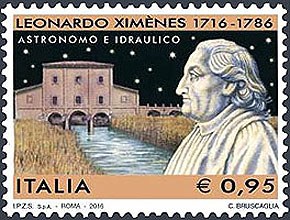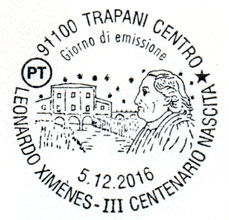

ITALY, December 2016, marking the 300th anniversary of his birth, with its cancel;
the stars and the Red House in this design represent respectively Ximenes' work in astronomy and hydroponics.
Leonardo Ximenes (27 December 1716 – 4 May 1786), born in Trapani, Sicily, after attending a Jesuit school, he entered the Order and became a mathematician, geographer, a hydraulic and civil engineer, and was an eminently respected astronomer in his day.
In 1756 Ximenes founded, on the upper floor of the monastery of San Giovannino, a small astronomical observatory, the first in the city of Florence, which after the Suppression of the Jesuits, was entrusted to the Scolopian (or Piarist) Fathers. When Ximenes died, his will provided for chairs there in astronomy and hydraulics, which remained active up to the middle of the 19th century. In 1813 the activity of weather forecasting was added, and in the mid-19th century, its astronomical activity having ceased, the Ximeniano (so named in his honor) added the new science of seismology.
Ximenes restored the gnomon in the dome of the Florence Cathedral and used this light focusing device to perform many experiments. He also installed the meridian line the cathedral floor. His 1557 work, Del vecchio e nuovo Gnomone fiorentino [Concerning the Old and the New Florentine Gnomon] included a compendium of the history of astronomy in Tuscany.
In the second half of the 18th century Ximenes directed the work for the Royal Pistoiese Road (today's Via di Brozzi) which connected the Grand Duchy of Tuscany with the Duchy of Modena. The infrastructure represented one of the boldest construction projects of the 18th century in Tuscany. Along the road Ximenes designed two bridges over the Lima and Sestaione torrents.
For many years Ximenes surveyed, assessed, and improved the hydrological situation in the major swamplands of Tuscany, like Massaciuccoli Lake and the lake-marshes of Bientina. His best results were achieved in Maremma, around the lake of Castiglione della Pescaia, where the imposing Casa Rossa Ximenes, or Red House of Ximenes which he built in 1765-68 (seen on the commemorative stamp and its special FDI cancel) bears testimony to the water system he devised. Later known as the Ximenes House, it is now the seat of an interesting multimedia museum.